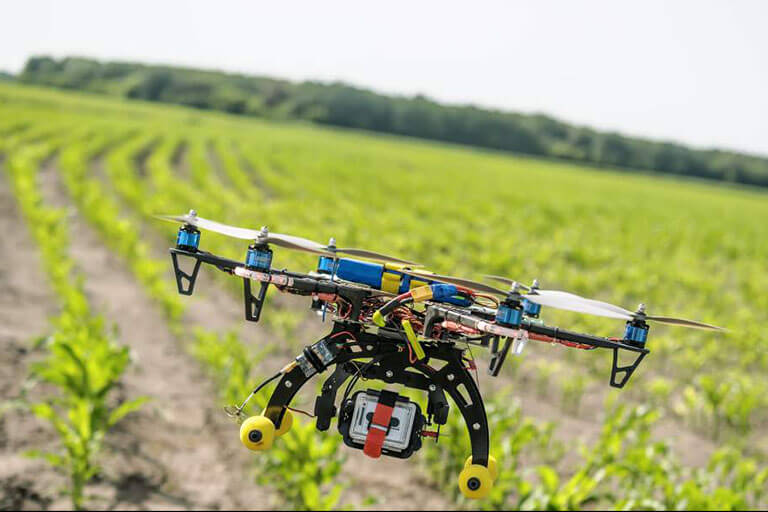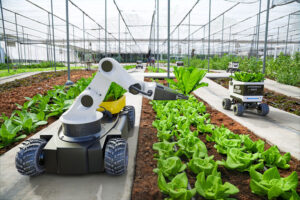 With the growing adoption of the Internet of Things (IoT), connected devices have appeared in every aspect of our life, from health and fitness, home automation, automotive and logistics, to smart cities and industrial IoT.
With the growing adoption of the Internet of Things (IoT), connected devices have appeared in every aspect of our life, from health and fitness, home automation, automotive and logistics, to smart cities and industrial IoT.
Its logical that eventually that IoT, connected devices, and automation would find its application in agriculture, and as is often the case improve nearly every aspect of it.
Farming has seen a number of technological transformations in the last decades, becoming more industrialised and technology-driven. By using various Connected devices and technology farmers have gained better control over the process of raising livestock and growing crops, making it more predictable and improving its efficiency. Its this ability to improve the efficiencies rather than just report on it that really starts to show the benefit of thinking in terms of the Internet of Everything rather than just IoT.
There are many ways to refer to modern agriculture. For example, AgriTech refers to the application of technology in agriculture in general.
Smart agriculture, on the other hand, is mostly used to denote the application of IoE solutions in agriculture. So what is smart agriculture using IoE? By using IoT sensors to collect environmental and machine metrics, farmers can make informed decisions, and improve just about every aspect of their work using technology – from livestock to crop farming.
This could include for example the use of sensors to monitor the state of crops, farmers being able to define exactly how many pesticides and fertilizers they have to use to reach optimal efficiency.
Although smart agriculture IoT, as well as industrial IoT in general, aren’t as popular as consumer connected devices; yet the market is still very dynamic. The adoption of IoT solutions for agriculture is constantly growing. Recent disruptions in the supply chain, and the shortage of qualified workers, has propelled its CAGR to 9.9%. At the same time, the global smart agriculture market size is expected to triple by 2025, reaching $15.3 billion (compared to being slightly over $5 billion back in 2016).
Technologies and IoT have the potential to transform agriculture in many aspects. Here are just some of the ways IoT can improve agriculture:
Data, tons of data, collected by smart agriculture sensors, e.g. weather conditions, soil quality, crop’s growth progress or cattle’s health. This data can be used to track the state of the business in general as well as staff performance, equipment efficiency, etc.
Better control over the internal processes and, as a result, lower production risks. The ability to foresee the output of your production allows you to plan for better product distribution. If you know exactly how much crops you are going to harvest, you can make sure your product won’t lie around unsold. This is IoE at its best.
Cost management and waste reduction thanks to the increased control over the production. Being able to see any problems in the crop growth or livestock health, you will be able to mitigate the risks of losing your yield before they become a crisis.
By using smart devices, you can automate multiple processes across your production cycle, e.g. irrigation, fertilising, or pest control. This can give better control over the production process and maintain higher standards of crop quality and growth capacity through automation. As a result, all of these factors can eventually lead to higher revenue
There are many types of IoT sensors for agriculture as well as IoE applications in agriculture in general:
Monitoring of climate conditions
Probably the most popular smart agriculture gadgets are weather stations, combining various smart farming sensors. Located across the field, they collect various data from the environment and send it to the cloud. The provided measurements can be used to map the climate conditions, choose the appropriate crops, and take the required measures to improve their capacity (i.e. precision farming).
Greenhouse automation
Typically, farmers use manual intervention to control the greenhouse environment. The use of IoT sensors enables them to get accurate real-time information on greenhouse conditions such as lighting, temperature, soil condition, and humidity.
In addition to sourcing environmental data, weather stations can automatically adjust the conditions to match the given parameters. Specifically, greenhouse automation systems use a similar principle.
Crop management
Crop management devices, just like weather stations, they should be placed in the field to collect data specific to crop farming; from temperature and precipitation to leaf water potential and overall crop health.
Thus, you can monitor your crop growth and any anomalies to effectively prevent any diseases or infestations that can harm your yield.
Cattle monitoring and management
Just like crop monitoring, there are IoT agriculture sensors that can be attached to the animals on a farm to monitor their health and log performance. Livestock tracking and monitoring help collect data on stock health, well-being, and physical location.
For example, such sensors can identify sick animals so that farmers can separate them from the herd and avoid contamination. Using drones for real-time cattle tracking also helps farmers reduce staffing expenses.
Precision farming
Also known as precision agriculture, precision farming is all about efficiency and making accurate data-driven decisions. It’s also one of the most widespread and effective applications of IoE in agriculture.
By using IoT sensors, farmers can collect a vast array of metrics on every facet of the field microclimate and ecosystem: lighting, temperature, soil condition, humidity, CO2 levels, and pest infections. This data enables farmers to estimate optimal amounts of water, fertilizers, and pesticides that their crops need, reduce expenses, and raise better and healthier crops.
For example, companies have created IoT soil sensors that measure soil moisture, temperature, and electric conductivity enabling farmers to approach each crop’s unique needs individually. Combined with geospatial data, this technology helps create precise soil maps for each field, helping farmers reduce waste, improve yields, and increase farm sustainability.
Agricultural drones
Perhaps one of the most promising agritech advancements is the use of agricultural drones in smart farming. Also known as UAVs (unmanned aerial vehicles), drones are better equipped than airplanes and satellites to collect agricultural data. Using multispectral image analyses allow estimates of the health of crops to be performed at a low cost. Apart from surveillance capabilities, drones can also perform a vast number of tasks that previously required human labor: planting crops, fighting pests and infections, agriculture spraying, crop monitoring, etc.
Predictive analytics for smart farming
Precision agriculture and predictive data analytics go hand in hand. While IoT and smart sensor technology are a goldmine for highly relevant real-time data, the use of data analytics helps farmers make sense of it and come up with important predictions: crop harvesting time, the risks of diseases and infestations, yield volume, etc. Data analytics tools help make farming, which is inherently highly dependent on weather conditions, more manageable, and predictable.
End-to-end farm management systems
A more complex approach to IoE systems in agriculture can be represented by the so-called farm productivity management systems. They usually include a number of agriculture IoT devices and sensors, installed on the premises as well as a powerful dashboard with analytical capabilities and in-built accounting/reporting features. This offers remote farm monitoring capabilities and allows you to streamline most of the business operations.
According to the UN Food and Agriculture Organization (FAO), the global population is expected to surpass 9 billion people by 2050. To produce enough food for the given population, agriculture production volumes have to increase by 50%.
As the resources for agricultural operations are limited (most of the lands suitable for farming are already in use), the only way to increase volume is to improve production efficiency and IoE is one of the main ways that this can be achieved.















